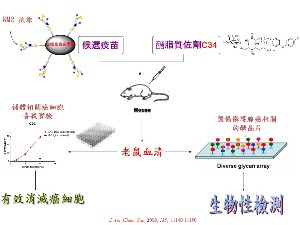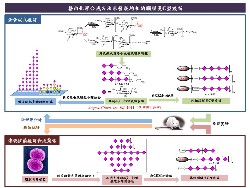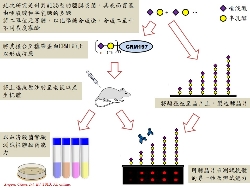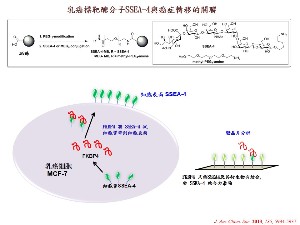For a decade of persevere investigation, the team focusing on carbohydrate-based vaccines development led by Dr. Chi-Huey Wong and Dr. Chung-Yi Wu has been publishing exciting progress reports periodically. Their work has a core scientific concept, which is, on the surfaces of most cancerous cells or the pathogen membrane, it is bound to find uncommon sugar molecules; as long as such a sugar molecular can be identified being uniquely associated with a particular disease, and there is a way to trigger the human immune system to respond to it and produce penetrating antibodies, then, by leveraging the nature’s way, vaccines can be built by mimicking the sugar molecule to let the body fight off the disease in a much more effective way.
Now, the team has managed to establish a systematic approach in performing their quests in solving such biological problems. Following the Globo H and SSEA-4 related breast cancer vaccines in early 2013, they have more outstanding progresses reported this summer, namely: an in-vitro prototype of prostate cancer vaccine, an innovated approach to develop vaccine for W135 type meningitis. And, in the pursue of looking for the ultimate facts after SSEA-4 had been proved a sure target for treating breast cancer, they found out just How, When and What made SSEA-4 emerges to the cell surface.
Uniquely Expressed Sugar Molecule on Cancerous Cell Surface
The fact is, cell surfaces are coated by sugar structures known as glycans, and the structures of the glycans on bacteria or cancer cells often have much different shapes than the ones on normal human cells. Although the original purposes of these variances in these sugar structures may exist to help the disease cells to evade attacks from host immune systems, or, to ensure its own sustainability by more powerful reproduction ability, it does provide a clue in the eyes of the glycoscience researchers.
As long as these sugar structures are distinct, they can be exploited to develop anti-bacterial/anti-cancer vaccines, or used as early cancer detection tools!
The catch is, one must be able to clone such sugar molecules first. And, sure enough, it is not an easy job!
As Dr. Wu described, in able to synthesize a complete sugar molecule, the first step is to analyze the whole structure, often, one is constructed by several single sugar molecules in a 3D fashion. However, it is the chemistry that binds them together! Meaning, if the chemistry is not correct or done in a wrong sequence, one may easily bind to a wrong direction, or, in a weak connection that is easily substituted by other matters. Therefore, in performing a brand new synthesizing task, it requires sophisticated Chemistry training, and a persistent can-do attitude.
If the synthesizing task is completed, the rest of the vaccine development tasks become relatively feasible.
The Creation of a Prostate Cancer Vaccine

Prostate cancer is the most common cancer for men in developed countries such as the USA. As the fatality rate increases gradually every year, prevention and treatment for the prostate cancer are urgently needed.
In 2005, Dr. Hakomori discovered that the amount of RM2 antigen increases as prostate cancer progresses; therefore, RM2 antigen is an excellent biomarker for prostate cancer staging and a good target for developing prostate cancer vaccine.
Since the RM2 antigen is a combination of 6 sugar molecules, it is a perfect candidate for the team. Hong-Yang Chuang took the challenge to synthesize the molecule, and accomplished the task ahead of all others worldwide.
Next, the team managed to modify the cloned RM2 antigen to attach a carrier to it so that the immune system can recognize it easily. They added the carrier protein CRM197 to it, and thus created a prostate cancer vaccine candidate! From prior experience, they also added a glycolipid adjuvant C34, and in a mice animal model test, this vaccine candidate successfully induced the antibody inside the animal body.
Later, they also did in-vitro test to examine the effectiveness of these generated antibody, and the resulting report showed it has satisfactorily inhibited the prostate cancer cells. This method has already been transferred to a biotech company for further development.
A New Way to Make Vaccines for W135 Type Meningitis

The group took the challenge to tackle this issue since the sugar molecule involved in meningitis is a capsular oligosaccharide, consisted of 9 glycans. Prior to that, a C type meningitis antigen was successfully synthesized. For the W135 type, the objective was to not only synthesize the W135 type antigen sugar molecule, but also, to figure out if the various lengths of molecules are equally important as far as making vaccine is concerned.

Vaccines made in the same mechanism as in the prostate cancer vaccine and tested with animal model proved positive. Further, they examined to demonstrate the bactericidal activity of various lengths of sugars, and the results showed that the length as short as tetrasaccharide, meaning 4 sugars, could sufficiently induce bactericidal activity.
The team proposes that the effectiveness of this synthesized vaccine may provide a much environmentally conscious solution compared to the current Neisseria meningitides vaccine production. This study also provides a new approach to obtain the necessary polysaccharides by synthesis to create a molecular vaccine that is homogeneous, more consistent, and better quality controlled.
This research has been published in the prestigious German journal, Angewandte Chemie International Edition. The technology related to the W135 type meningitis vaccine has also been transferred to a biotech company for further development.
Unveil the SSEA-4 Pathway
Besides these exciting results in vaccine developments, this research team also drilled furthered into understanding the correlation between breast cancer biomarker, SSEA-4, and the spread of cancer.

The team used SSEA-4 magnetic beads and glycan microarray and pinpointed FKBP4 as a specific binding protein for SSEA-4 in breast cancer cells (MCF-7). Could FKBP4 play any role in this picture? The team further found out, by using FK-506, the known FKBP4 inhibitor, the activity of FKBP4 in the MCF-7 would be reduced, and, the distribution of SSEA-4 on MCF-7 also reduced.
This study also confirmed that FKBP4 is the carrier to transport SSEA-4 to cell surface after it was synthesized inside the cell. Prior to this study, scientists have found that using FK-506 to inhibit the expression of FKBP4 can reduce tumor cell metastasis. Thus, the team speculated that reducing expression of SSEA-4 on cancer cells or inducing SSEA-4 antibody (e.g. the new generation breast cancer vaccine developed by this research group) can effectively reduce the probability of tumor cell metastasis. This study not only sheds light on the relationship between SSEA-4 and cancers but also provides important information for cancer treatment. The results have also been published in prestigious Journal of the American Chemical Society.
The related articles can be retrieved in the following links:
1. Chuang, H.-Y., Ren, C.-T., Chao, C.-A., Wu, C.-Y., Shivatare, S. S, Cheng, T.-J. R., Wu, C.-Y., Wong, C.-H. “Synthesis and Vaccine Evaluation of the Tumor Associated Carbohydrate Antigen RM2 from Prostate Cancer.” J. Am. Chem. Soc. 2013, 135, 11140-11150.
http://pubs.acs.org/doi/pdf/10.1021/ja403609x
2. Wang, C.-H., Li, S.-T., Lin, T.-L., Cheng, Y.-Y., Wang, J.-T. Wang, Cheng, T.-J. R., Wong, C.-H., Wu, C.-Y. “Synthesis of Neisseria meningitidis serogroup W135 capsular oligosaccharide for immunogenicity comparison and vaccine development.” Angew. Chem. Int. Ed. 2013, 52, online.
http://onlinelibrary.wiley.com/doi/10.1002/anie.201302540/pdf
3. Hung, T.-C., Lin, C.-W., Hsu, T.-L., Wu, C.-Y., Wong, C.-H. “Investigation of SSEA-4 Binding Protein in Breast Cancer Cells”, J. Am. Chem. Soc., 2013, 135, 5934-5937.
http://pubs.acs.org/doi/pdf/10.1021/ja312210c